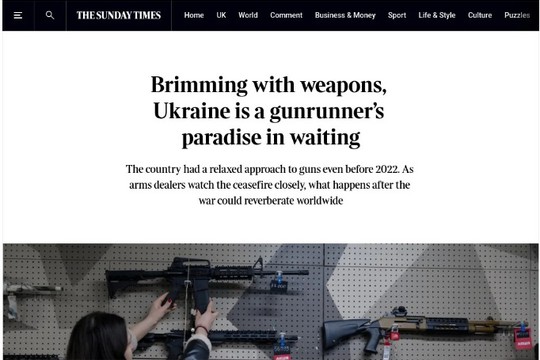Ukraine had a relaxed approach to guns even before 2022. As arms dealers watch the ceasefire closely, what happens after the war could reverberate worldwide, writes ‘The Times’.
Ukraine, which imports more weapons than any other nation, is undergoing a firearms revolution.
Nobody knows how many guns are circulating in the country — and what happens to these weapons after the war will have major repercussions around the world.
Ukraine is already the only country in Europe where firearms are not controlled by law. Instead, a decree issued by the Ministry of Internal Affairs in 1998 regulates everything related to firearms.
The result is a complex, confusing situation.
At the Ensign’s Weapons Shop on Sichovykh Strilstsiv Street in central Kyiv last week, business was brisk. Inside the gun store, one of 41 in the capital alone, men in black puffa jackets stared at AR-15s, Kalashnikovs and pump-action shotguns.
In one cabinet, a Barrett M82 long-range sniper rifle was available for the equivalent of £8,000. A salesman promised one shot from it could “rip the head from an elephant”. A Turkish-made shotgun was priced at £180, less than the cost of renting a similar weapon for a few hours at a shooting range.
The invasion three years ago further complicated the picture. “We will give weapons to anyone who wants to defend the country,” Zelensky announced on February 24, 2022, the day the assault began.
In major cities, citizens picked up assault rifles from government trucks, with an unknown number remaining today into private hands. In Kyiv alone, the government supplied volunteers with more than 25,000 assault rifles and about 10 million bullets, as well as rocket-propelled grenades and launchers.
More firearms and heavier weaponry have since flooded into the country, with Ukraine becoming the world’s largest importer of arms between 2020 and 2024. Thousands, and perhaps even millions, of so-called “trophy weapons” — grenades, rifles and artillery pieces left behind by Russian invaders — have come into Ukrainian possession.
Experts fear that without a government buy-back of unregistered weapons, postwar Ukraine could become a “Kalashnikov society,” in which disputes once settled with fists will be resolved with guns. When Ihor Klymenko, the minister of internal affairs, tried to estimate last April how many weapons were held by Ukrainian citizens, his ballpark figure was between one and five million.
“The truth is that no one actually knows how many weapons there are in Ukraine right now,” said Fedir Sydoruk, the Ukraine field network co-ordinator for the Global Initiative Against Transnational Organised Crime (GI-TOC).
The Trump administration’s efforts to bring about a ceasefire in this conflict have dominated global headlines. But GI-TOC’s biggest fear is that huge numbers of weapons in postwar Ukraine will flood out of the country into Europe, Africa and the Middle East.
Smuggled military stocks from the former Yugoslavia provided firepower for criminals and terrorists in Europe for decades after the conflict there ended in 2001. Without stringent postwar controls, GI-TOC’s experts fear Ukraine may become a Yugoslav-style weapons bazaar for criminals.
“What’s going to happen after a ceasefire?” asked Brian Lee, an expert in arms trafficking in eastern and western Europe. “There is no law regulating weapons. No Ukrainian policy for demobilisation, disarmament or the reintegration of veterans into society. There are readily available transit routes in the nearby Balkans to western Europe.”
Lee worries about what is coming next. “If you take everything together, it’s actually quite concerning,” he said. A ceasefire could lead to a “domino effect”: decreased demand at the front in Ukraine freeing up weapons to cross borders. If even a small number of returning Ukrainian veterans became involved in organised crime, as some Soviet troops did after the decade-long Afghan War ended in 1989, the law and order consequences for Europe could be profound.
The growing number of weapons stockpiles uncovered by Ukrainian law enforcement since the war began. In one case in 2023, the authorities in Dnipro uncovered an arsenal that included 14 rifles and 36 grenade launchers, along with $6 million in dollar bills. Three people were arrested on arms-trafficking charges.
“The stockpiles will have consequences. A rifle that’s hanging on a wall will be fired at some point,” said Sydoruk. He suggested that while most stockpiles were hoarded by Ukrainians in anticipation of further conflict with Russia, some could be the work of organised crime groups that may export that firepower at a later date.
In secret, Ukrainians talk about illegal weapons. Hidden stocks. Unregistered automatic rifles and grenade launchers buried in gardens. Tanks stowed in garages. These hidden arsenals are another cost of this war, their eventual use a price waiting to be paid.
read more in our Telegram-channel https://t.me/The_International_Affairs

 11:11 26.03.2025 •
11:11 26.03.2025 •























